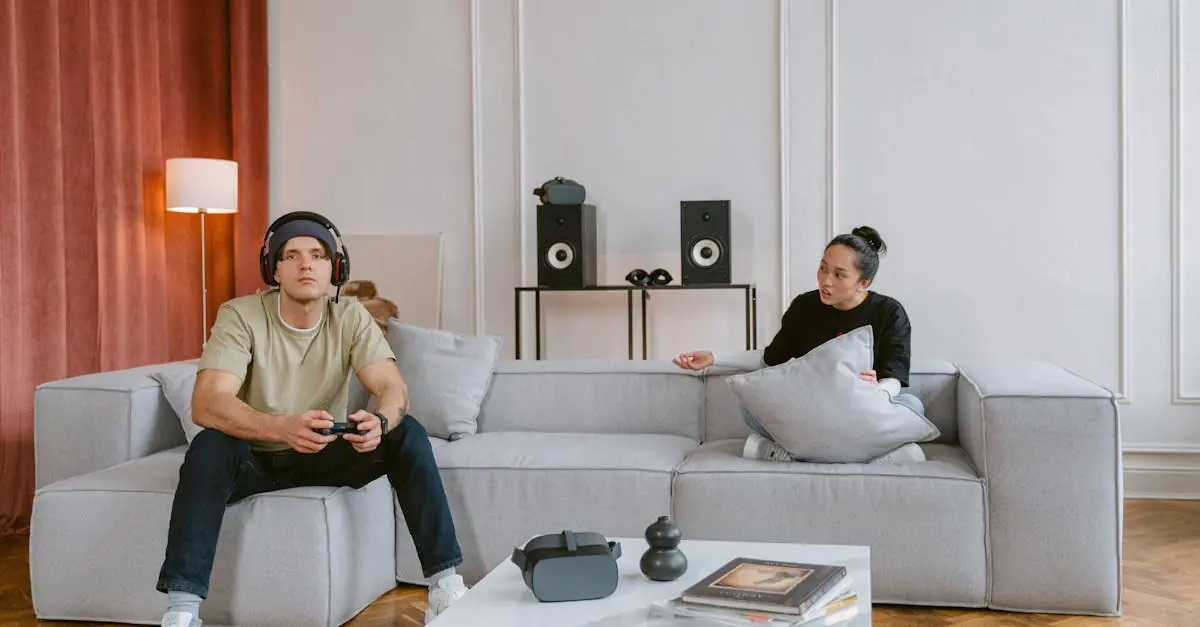Imagine stepping into a world where reality takes a backseat and adventure reigns supreme. Welcome to the virtual reality game room—a space where the ordinary transforms into the extraordinary. Whether you’re battling aliens or exploring mystical lands, this immersive experience is designed to thrill and entertain.
Table of Contents
ToggleOverview of Virtual Reality Game Rooms
Virtual reality game rooms offer players an immersive escape into digital worlds. Equipped with advanced technology, these spaces feature high-resolution headsets and motion tracking systems. Users can step into environments that stimulate the senses, transporting them far from reality.
Gameplay in these rooms encompasses a wide range of activities. Participants often engage in adventures like combat scenarios, puzzle-solving, or socializing with others in virtual settings. The experiences vary, catering to different interests and skill levels, enhancing accessibility for all players.
Design elements play a significant role in a virtual reality game room. Comfortable furniture supports extended play sessions, while optimal lighting reduces eye strain. Thoughtful layout planning also encourages free movement, allowing players to fully immerse themselves without obstacles.
Technological advancements drive the evolution of these game rooms. Newer features include haptic feedback devices that simulate touch and environmental effects that enhance realism. Additionally, cloud gaming options enable users to access a library of VR titles without hefty hardware requirements.
Safety measures are crucial in these dedicated spaces. Staff often provide guidelines to ensure a secure atmosphere, advising players on boundaries and potential hazards. Regular equipment maintenance keeps the technology in peak condition, enhancing user experience.
Overall, virtual reality game rooms create unique opportunities for adventure and fun. Users not only enjoy gaming but also social interaction and physical activity. As interest grows, opportunities for VR gameplay continue to expand, shaping the future of entertainment.
Benefits of Virtual Reality Game Rooms
Virtual reality game rooms offer various advantages, enhancing gameplay and social experiences through immersive technologies.
Immersive Experience
Immersion captivates players, allowing them to engage deeply with virtual environments. High-resolution headsets and motion tracking create realistic sensations, making each adventure feel lifelike. For example, players can feel the rush of wind during a thrilling chase or the intensity of an action-packed battle. Engaging with intricate storylines alongside stunning graphics keeps users fully absorbed. Virtual reality brings together audio and visual elements, elevating the overall experience beyond traditional gaming setups. Users encounter a blend of excitement and realism, encouraging longer play sessions and greater enjoyment.
Social Interaction
Social engagement thrives in virtual reality game rooms, fostering connections among players. Multiplayer capabilities allow friends to join adventures in real-time, collaborating to overcome challenges. Participants share experiences, collaborate on puzzles, or engage in competitive gameplay, creating bonds. Virtual reality brings together diverse gamers, enabling interaction across different backgrounds and skill levels. Additionally, the environment encourages friendly competition, enhancing social dynamics. Group activities in a virtual setting promote camaraderie and communication, making the gaming experience more enjoyable. Overall, social interactions in these spaces transform casual gaming into a shared journey.
Key Components of a Virtual Reality Game Room
Essential components shape the effectiveness of a virtual reality game room, providing the tools needed for an immersive experience.
VR Headsets
VR headsets serve as the primary navigation tool in virtual worlds. Various models are available, catering to different preferences and budgets. High-resolution displays immerse users in lifelike graphics, making adventures feel authentic. Audio quality enhances realism, allowing players to hear enemies approaching from different angles. Advanced features, such as wireless capabilities, eliminate tangling cables, promoting ease of movement. Popular options include the Oculus Quest 2 and Valve Index, recognized for their performance and design.
Motion Sensors
Motion sensors track user movements, translating them into the virtual space with precision. They detect shifts in position and gestures, creating responsive interactions. Systems may utilize infrared cameras or base stations to capture an expansive play area. Seamless integration with headsets enhances the user experience by reflecting movements accurately. Enhanced interaction fosters deeper immersion, with players engaging in activities like dodging or reaching for virtual items. Companies such as HTC Vive and PlayStation employ sophisticated motion tracking to elevate gameplay quality.
Accessories
Accessories play a crucial role in enriching virtual reality experiences. Controllers equip players with intuitive mechanisms for interaction, ranging from hand movements to specialized buttons. Haptic feedback devices deliver tactile responses, intensifying immersion by simulating real-world sensations. Additional items, such as VR gloves, allow for nuanced interactions, promoting a vivid sense of presence. Comfort accessories, including adjustable straps and cushioned eyepieces, ensure extended play without discomfort. Overall, these enhancements create a more engaging and enjoyable gaming environment.
Popular Virtual Reality Games for Game Rooms
Several popular virtual reality games enhance the gaming experience in game rooms. Titles like Beat Saber combine music and rhythm, allowing players to slash through blocks to the beat of their favorite songs. Engaging gameplay encourages physical movement, making it a favorite among users.
Another well-known title, Half-Life: Alyx, immerses players in a rich storyline set in the Half-Life universe. This first-person shooter emphasizes environmental interaction, challenging players to solve puzzles while combating enemies. The detailed graphics and captivating plot create a memorable experience.
The Walking Dead: Saints & Sinners offers a unique survival horror experience, where players navigate a post-apocalyptic world filled with zombies. Choices impact the outcome, providing a personalized gameplay experience. This title showcases the depth of decisions in VR gaming.
For multiplayer experiences, Rec Room stands out as a social platform where players can create and share games. Users can engage in various activities, from paintball to escape rooms, encouraging teamwork and collaboration. This diversity in gameplay caters to varying interests within game rooms.
VRChat also enriches social interaction through customizable avatars and vast virtual worlds. Players can meet new friends, explore creative spaces, and participate in user-generated events. This game epitomizes the social potential of VR gaming.
Lastly, Boneworks pushes the boundaries of physics-based interactions. Players navigate through procedurally generated environments, experimenting with realistic movements and mechanics. The game’s emphasis on realistic interactions enhances immersion significantly.
Incorporating these games into virtual reality game rooms can elevate the overall player experience, fostering engagement, competition, and memorable moments.
Setting Up Your Virtual Reality Game Room
Creating an immersive virtual reality game room involves careful planning and attention to detail. Focus on key elements like space and equipment to optimize the experience.
Space Requirements
Room dimensions play a crucial role. Ideally, a dedicated area of at least 10 feet by 10 feet is recommended to ensure players can move freely. Ceiling height matters, with a minimum of 8 feet allowing for comfortable movement and gameplay. Clear any obstacles that could interfere with gameplay. Ground surfaces should be non-slippery to prevent accidents. Accessibility is vital, accommodating players of various needs, ensuring everyone enjoys the VR experience.
Equipment Setup
Selecting the right equipment enhances immersion. Start with a high-quality VR headset, like the Oculus Quest 2 or Valve Index. Ensure compatibility with motion sensors that accurately track movements. Position these sensors at strategic angles for optimal performance, ideally elevated to avoid obstructions. Controllers should be within easy reach, fostering seamless interaction during gaming. Incorporate comfortable seating or standing mats, ensuring physical comfort. Regularly check and maintain equipment to avoid technical issues, creating a reliable gaming environment.
Virtual reality game rooms represent a revolutionary shift in entertainment. They offer players an unparalleled opportunity to dive into captivating digital worlds that blend adventure with social interaction. With advanced technology and immersive gameplay, these spaces cater to a wide range of interests and skill levels.
As the popularity of VR continues to grow, the design and functionality of game rooms will evolve further. Investing in quality equipment and thoughtful layouts ensures an enjoyable experience for all. Whether battling aliens or solving puzzles, the virtual reality game room is more than just a gaming space; it’s a gateway to unforgettable experiences and lasting memories.


